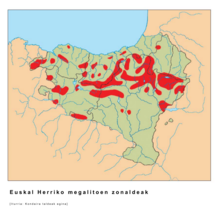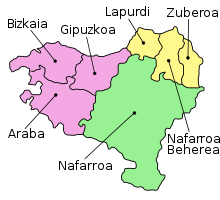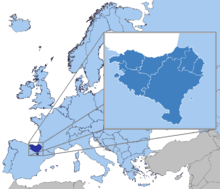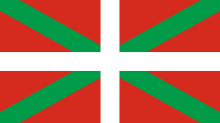Basque Country (greater region)
![]()
This article deals with the Basque Country as a cultural-geographical area. For the political administrative unit of the same name in Spain, see Autonomous Community of the Basque Country, for the French part Basque Country (France).
The Basque Country (Basque Euskal Herria or Euskadi, Spanish País Vasco or Vasconia, French Pays Basque) is a region located at the southern tip of the Bay of Biscay on the Atlantic Ocean in the territory of the modern states of Spain and France. The Spanish Basque Country includes the three provinces of the Spanish Autonomous Community of the Basque Country; in addition, depending on the ideological point of view, the Autonomous Community of Navarre (Basque: Nafarroa) is also considered part or all of the Basque Country. The French Basque Country, called Iparralde ("Northern Basque Country") in Basque, forms the western part of the French department of Pyrénées-Atlantiques.
The extent of the Basque Country is politically and socially controversial and is discussed in the area of tension between Basque, Spanish and French nationalism. There is controversy above all about the affiliation of Navarre to the Basque Country, since the south of this province, which is historically closely interwoven with the rest of the Basque Country, has long since ceased to belong to the narrower Basque-speaking area. The Burgalesian enclave of Treviño, which for historical reasons belongs to Castile, has less than 1,500 inhabitants, a large majority of whom are in favour of their territory being included in the Basque province of Álava (Araba), which is why the municipality is also counted as part of the Basque Country in terms of cultural landscape.
The Basque Country (Euskadi) is named after the Basque people (Euskaldunak - "Basque speakers"). After the repressions of the 20th century, especially during the Franco dictatorship, the Basque language (Euskara or Euskera) has meanwhile regained a strong spread through targeted promotion at regional level, especially through Basque-language schools (Ikastolas).

The department of Pyrénées-Atlantiques comprising the French Basque Country and the province of Béarn

Megalithic zones in the Basque Country

Basque language area in the Bay of Biscay, light - low proportion of Basque speakers, dark blue - high proportion of Basque speakers

Division of the Basque Country: Autonomous Region of the Basque Country Autonomous Region of Navarre French Basque Country

Location of the Basque Country

The flag of the Basque Country
Geography
The Basque Country is bordered by the Cantabrian Sea (Bay of Biscay) on the seaward side and by the Ebro River to the south. In its parts of the Ebro lowlands, however, the Basque population is very small.
In terms of landscape, the Basque Country essentially consists of the transition from the Pyrenees (Pirinioak in Basque) to the Cantabrian Mountains (Kantauriar mendilerroa in Basque). South of the Pyrenees, the land slopes only slowly towards the Ebro basin. On the north side, however, the valley level into the mountains is only 100 msnm. The highest peak of the Basque Country is the Table of the Three Kings (Basque Hiru Erregeen Mahaia) with 2444 msnm at the border triangle (2421 m) of Navarra (E), Aragón (E) and Béarn (F). It is followed by the 2007 m high Orhi on the border of Navarre with the French Basque Country (thus the highest mountain within the Basque Country) and the 1551 msnm high Aitxuri in Gipuzkoa. In the valleys of the provinces of Bizkaia and Gipuzkoa, numerous cities crowd, outside the winding old towns industrial.
To the west and southwest, the Basque Country borders the Spanish autonomous communities of Cantabria and Castile-León, to the south the Spanish autonomous community of La Rioja, to the southeast the Spanish autonomous community of Aragon, to the north the French department of Landes, and to the northeast the historic province of Béarn, with which the French part of the Basque Country now forms the department of Pyrénées-Atlantiques.
The climate on the north side of the inner-Iberian mountains is mild at all times of the year and clearly influenced by the nearby Atlantic and thus humid maritime climate. For this reason, the Basque Country is very green and rich in vegetation compared to the interior. The Ebro Basin, on the other hand, is more continental in character, comparatively low in precipitation and sometimes extremely hot in summer.
Political division
Politically, the Basque Country today consists of three different areas:
- The Spanish Autonomous Community of the Basque Country (Basque Euskadi) comprises the three provinces of Gipuzkoa (Spanish Guipúzcoa), Biscay (Basque Bizkaia, Spanish Vizcaya) and Álava (Basque Araba). The capital of the autonomous region is Vitoria-Gasteiz. Other important cities are Bilbao and Donostia-San Sebastián, capitals of the provinces of Bizkaia and Gipuzkoa respectively.
- The Spanish autonomous region of Navarre (Nafarroa in Basque) is not part of the Autonomous Community of the Basque Country; in its northern part, Basque is a common and official language.
- The French part of the Basque Country (Basque Iparralde) includes the three historic herrialdes (territories) of Lapurdi (French Labourd), Zuberoa (French Soule) and Behenafarroa or Nafarroa Behera (French Basse-Navarre).
In today's Basque language, the entirety of the historical territories of the Basque Country, which today belong to Spain and France, is referred to as Euskal Herria, while the term Euskadi is used primarily for the Autonomous Region of the Basque Country. The southern (Spanish) parts of the Basque Country are also called Hegoalde in Basque, while the northern (French) parts are called Iparralde.
Search within the encyclopedia